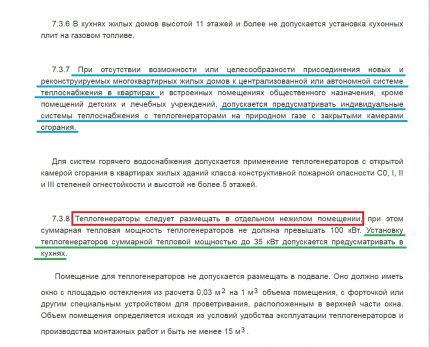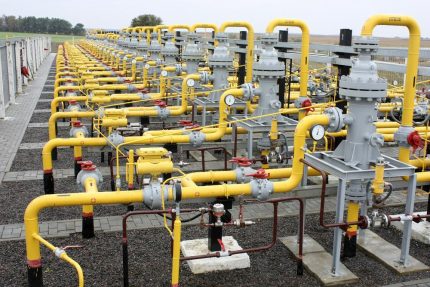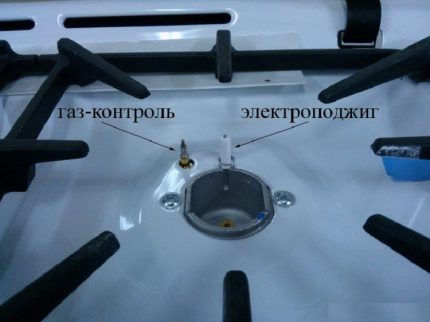To which floor are gasified houses: legislative norms and rules for the gasification of high-rise buildings
The number of high-rise buildings is growing every year, along with their possible number of storeys. And the higher the person “climbs”, the more expensive the apartment. But at the same time, not all modern benefits are available to the lucky owners of a panoramic view of the city. Legislative documents used to strictly regulate to which floor the houses are gasified, however, the norms and laws are constantly changing, the data of recommendatory and binding documents vary.
Agree that, relying, for example, on the long-awaited housing in a new building, I want to know in advance all the nuances and technical capabilities.
When the “blue fuel” already appears in each apartment, is it possible to gasify the entire skyscraper with an autonomous gas tank, to which floor does the main gas reach, and what documents standardize the rules for supplying them with MKD? We will try to answer you in detail to these and many other questions.
The content of the article:
Documents governing gasification
The law determines that on the site officially registered as IZHS, it is impossible to erect houses whose storeys above the base level exceed 3 levels or 12 meters from the ground to the level of the roof ridge.
Even according to the old regulations and laws, restrictions on gasification began only from the 5th floor. Therefore, we initially, discussing which floor or footage above ground level, it is impossible to carry out gas, intentionally postponed individual housing construction and started talking about the possibility of equipping apartment buildings, starting from level 5.
For starters, we’ll deal with autonomous gas supply.
“Technical regulation on the safety of home gas equipment” in paragraphs 1.2 and 1.3 it states that fuel can be supplied from tank installations to buildings of up to 10 floors, in the case of group balloon installations, no more than 5 floors.
That is, autonomous supply is possible from 5 to 10 floors, depending on the type of devices used in the distribution, it is unlikely that you can arrange the supply above.
One of the first documents that normalized the gas supply of high-rise buildings was SNiP 2.08.01-89 "Residential buildings". It has a veto on the installation of gas boilers and pipes leading to them above the 5th floor, however gas stoves are allowed to be installed up to 11.
The document lost its force in 2003; it was replaced by SNiP 01/31/2003 "Residential multi-apartment buildings"Incidentally, registered as mandatory at the state level.
But it was also written there that in houses with a height of 11 floors it is allowed to install electrical appliances for cooking. At the same time, boilers with a closed combustion chamber are allowed. By the way, for some reason, many people claim that this document, as well as for 1989, completely prohibited gas supply in high-rise buildings.
Another amazing thing is that these 2 documents are still advised and cited as relevant, although both of them have completed their action.

But instead of them there appeared a joint venture for 2011 and then for 2016. And just in the updated version, the paragraph on the altitude of gasification was generally abolished. They do not reflect in any way information on which floor the supply of “blue” fuel is limited.
And on June 6, 2019, by order of the Ministry of Construction, it was put into effect SP 402.1325800.2018 “Residential buildings. Rules for the design of gas consumption systems "designed for highways in which gas is used as a resource in accordance with GOST 5542 with a pressure of up to and including 0.005 MPa. This is just one of those cases when a joint venture is entered into the registry as mandatory.
And immediately you can pay attention to paragraphs 5.16-5.18, which contain instructions on the placement of gas consumption devices in the MKD with a height of not more than 28 meters. However, there are no prohibitions on installation in excess of this norm. Why exactly 28 meters?
Because safety regulations are normalized, in houses higher than 28 meters, coordination with the Ministry of Emergencies and other structures is required.
Let's see two more documents. SP 60.13330.2012 “Heating, ventilation and air conditioning” and SP 41-108-2004 "Apartment heating of residential buildings with gas-fired heat generators" - In almost direct text it is indicated that there are no restrictions on the gasification of multi-storey residential buildings for 5, 10, 11 floors or higher.
That is, theoretically, it is officially authorized and possibly at the legislative level, if the developer conducts the relevant approvals and all conditions are met.

But in practice, it is problematic to carry out the plan, although it is quite possible, especially since modern technical capabilities allow it.
A huge number of nuances still often do not allow the construction of high-rise buildings with gas supply.
Main gas in a high-rise building
As a rule, such work is carried out at the design stage of the high-rise. However, developers are extremely reluctant to implement this procedure. And that's why? Let’s take a look at the beginning of how the main gas enters the apartments.
From the distribution network, fuel enters the gas pipeline system. From it, it already goes to consumers via branches. It is far from always possible to conduct gas in an ordinary residential building due to overloading the line.
I have to go around the nearest input to gas pipes, often even to a neighboring subscriber network, because the gas pipeline’s possibilities are not unlimited, and it’s almost impossible to deliver gas to densely populated areas under the pressure required by law, from a single-line position.
According to TU, bypassing the obstacles in the fuel supply, sometimes you have to pay literally millions. And then the apartment building, and even a skyscraper. Imagine the number of subscribers.That is, to provide gas for one such house, a separate trunk line.

But this is not all “pitfalls”. There are a number of complex technical requirements in regulatory documents, including the aforementioned joint venture introduced on June 6.
To enter gas into the building, the following conditions must be observed:
- The presence of 2 isolated rooms for the development of the structure of branches.
- Special ventilation and exhaust systemcapable of removing mining products from all apartments.
- Corridor ceilings, not less than 1.6 m in height with a high degree of fire resistance.
- The project of the building, allowing the installation of risers in the kitchen and on the stairwells.
- A large number of valves on each section of the network.
- High pressure equipment and its adjustment for high-quality apartment gas supply.
- Equipping windows where gas equipment is located with an easy-to-remove glass structure.
- The gas control system on stoves and boilers.
- Emergency dispatch alert.
- Boilers power more than 50 kW exclusively in isolated rooms of the apartment.
- The presence of gas sensors with a gas cut-off system.
In addition, the same “Technical Regulation on the Safety of Home Gas Equipment,” but this time, without looking back to the gas holders and balloon installations, requires supplying only to buildings whose tiering will provide a practical possibility of eliminating fires.
At the same time, there is a tacit reservation that this also allows equipping the local fire system.

Thus, the partial supply of the skyscraper is almost impossible, and the final cost of the work on full gas supply, even at the design stage, will seem prohibitive.
Experts argue that it is simply unprofitable and technically difficult to carry out such work as part of a conventional high-rise apartment building.
What is the danger of gasification?
What is liquefied household gas? This is a mixture of propane and butane, which has no color and no smell. When we say “it smells of gas”, we technically make a mistake, since the fuel itself has no aromas.
An odorant is added to it - ethyl mercaptan, which has a characteristic unpleasant odor compared to rotten eggs or even stale meat. This is necessary so that a person can determine the leak in time with the help of smell.
Liquefied gas, as we recall from chemistry lessons, is heavier than air. In case of a leak, it “drains”, first of all, into the basement, filling them. In addition, in fact, from 5 to 15% of the gas of the volume of air in the room can easily provoke human poisoning and even a fire / explosion.
The number of gasified houses is growing every year. And with them, the number of victims of explosions of domestic gas. In 2018, there were 12 emergency situations in the country, with serious consequences, and this is just 3 months.
A huge number of major tragedies occurred in apartment buildings and for 2019 due to improper handling of gas or poor technical condition of fuel lines.

The explosion, even in a one-story private house, kills lives and brings severe damage. And here is a high-rise building with thousands of residents and guests.Moreover, a high structure with a common system of ceilings, the collapse of which is complete, can provoke even a small blast wave.
Another reason why the authorities have developed a number of restrictions that impede gasification is the problem of the technical feasibility of saving citizens living above 11 floors. These people are actually doomed in a medium-power explosion. Even if they miraculously survive, under the rubble of a large structure to find them alive, especially in the cold season, there is little chance.
Projects banning gasification of skyscrapers
After the abolition of SNiP in 2003, which prescribed bans and restrictions on the altitude of gas appliances, many structures and departments tried to reintroduce them, especially after a series of explosions.
So, at the end of 2017, such a proposal was made by Rostekhnadzor, urging to think about electrification. The deputies of Just Russia also made similar attempts. The initiators offer to introduce a veto at least in new buildings, even if they leave gasification in the already built houses with the replacement of stoves with appliances with maximum gas-control protection.
However, this is unlikely to happen. Almost all the tragedies are connected with the human factor, the technical ability fully allows the safe use of gas equipment in high-rise buildings.

Although many people understand that relying on the adequacy of their neighbors and the safety system of gas installations is not always advisable. There are cases when some residents of apartment buildings try to refuse gas, but their requests are not always satisfied for various reasons, such as, for example, poor wiring, not suitable for electric stoves.
It turns out a double edged sword. On the one hand, it is difficult to gasify a building, on the other, it is already equipped with such equipment - to electrify.
Conclusions and useful video on the topic
After a series of domestic gas explosions in the country, in many regions began to check distribution networks:
Technology does not stand still, resource-supplying organizations are getting more and more opportunities for the implementation of the most daring projects. Even before 2011, it was difficult to assume that “blue fuel” would ever appear in apartments above the 11th floor. And today there are no restrictions at all.
And although the project still seems crude and technically poorly thought out, we can safely say that another couple of years will pass, and residents of high-rise buildings will be able to use gas everywhere, and not just in rare, expensive projects.
And what do you think, to what floor should gasify the house - as in the old standards to 5-11 or without restrictions? Perhaps guests from the high-rise buildings already equipped with gas will appear here and share their experience? Write your questions and opinions in the comments, as well as participate in the discussion of this material.

 Underground gas storage facilities: suitable ways of storing natural gas
Underground gas storage facilities: suitable ways of storing natural gas  How much does it cost to connect gas to a private house: the price of organizing gas supply
How much does it cost to connect gas to a private house: the price of organizing gas supply  The best washing machines with dryer: model rating and customer tips
The best washing machines with dryer: model rating and customer tips  What is the color temperature of light and the nuances of choosing the temperature of the lamps to suit your needs
What is the color temperature of light and the nuances of choosing the temperature of the lamps to suit your needs  Replacement of a geyser in an apartment: replacement paperwork + basic norms and requirements
Replacement of a geyser in an apartment: replacement paperwork + basic norms and requirements
I fluently read the article and found at least 2 errors. Firstly, SP 402 is applied on a voluntary basis, and secondly, “TR on the safety of home gas equipment” is a bill that, as a result, the RF State Duma rejected in 2014 ...
Hello Olga. I explain.
Documents approved by the Ministry of Construction, but not included in the list of 1521, are documents of a voluntary basis.
Federal Law No. 463, Article 6: “PThe voluntary application of standards and (or) sets of rules included in the list of standardization documents specified in clause 1 of this article is a sufficient condition for compliance with the requirements of relevant technical regulations.In the case of applying such standards and (or) sets of rules to comply with the requirements of technical regulations, the assessment of compliance with the requirements of technical regulations may be carried out on the basis of confirmation of their compliance with such standards and (or) sets of rules. Non-application of such standards and (or) sets of rules cannot be assessed as non-compliance with the requirements of technical regulations.“. BUT: “In this case, it is allowed to use preliminary national standards of the Russian Federation, standards of organizations and (or) other documents to assess compliance with the requirements of technical regulations.”
That is, it does not mean that if the document is not in the list, you can not follow it. It only means that if the list contains documents that allow you to do something bypassing the voluntary rules, they can be used instead, but not completely ignored.
I quote: “The voluntary application of standards and (or) sets of rules included in the list of standardization documents specified in clause 1 of this article is a sufficient condition for compliance with the requirements of relevant technical regulations.“.
That is, existing joint ventures or SNiP, which are included in the list of compliance with technical regulations (and SP 402 is included), are fully suitable for compliance with legislative acts. The prerogative is enjoyed by documents in PP 1521, but are not the only laws. Any law that complies with applicable law is automatically active.
Voluntary joint ventures may not be respected only in parts that contradict the mandatory standardization documents and if they can be replaced by such documents. The explanatory letters of the Ministry of Construction also testify to this. You simply do not quite correctly interpret the concepts of “voluntary” and “mandatory”.
But that's not all. The list of 1521 includes documents on heat supply and gasification, which in fact stipulate almost all items of SP 402, and without that SP 402, as an abridged version, fits into this quite well.
Bottom line: since in SP 402.1325800.2018 there are no contradictions to the approved SP from the list and non-compliance with it cannot be replaced by other normative acts, this makes it MANDATORY. And there are no manipulations of the truth and evasions. Since there are still voluntary documents, the observance or non-observance of which is your right. Those that are NOT on the mandatory or voluntary list are not approved by the Ministry of Construction. That is, those that are RECOMMENDED in nature. You are talking about these documents.
You show us a document, please, in which you are allowed to not comply. Not talking about “Non-application of such standards and (or) sets of rules cannot be assessed as non-compliance with the requirements of technical regulations”, But how you will find an alternative for a particular joint venture that does not contradict the existing mandatory standards. Then I will agree with you.
Oh yes. You also remembered TR, it was canceled not in 2014, but in 2010, if I am not mistaken. But his requirements are quite reasonable. The layering of high-rise buildings cannot provide high-quality fire fighting in the technical equipment of MOST cities. I can give an example directly. And while he reaches the region, he arrives, he’ll already speak half the village. So here it’s rather not legislative, but reasonable to read this paragraph.
Here, of course, a very interesting situation) because of the wording “voluntary”. It implies “unnecessary” requirements that can be ignored, but a document upon the fact is mandatory in almost all paragraphs) they’ll “call” themselves, write documents, confirm them, and then complain that people scold them when the projects are being completed.
Here, of course, a very interesting situation is due to the wording “voluntary”. It implies “unnecessary” requirements that may not be complied with, and a document upon the fact of almost all paragraphs is mandatory.
They themselves will “call me”, write documents, confirm them, and then complain that people scold them when projects are being completed.